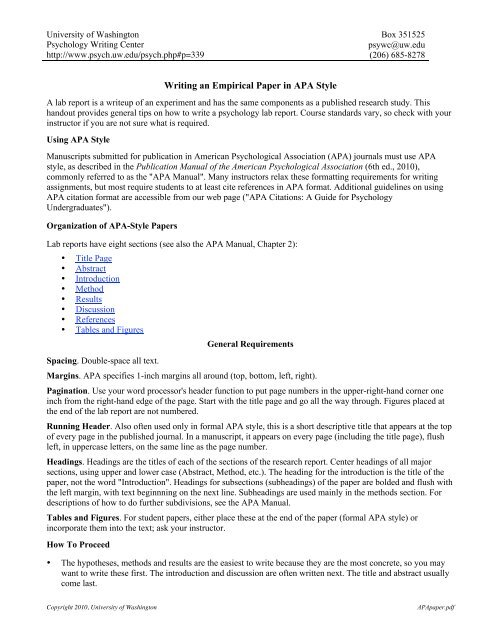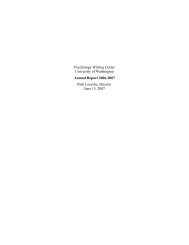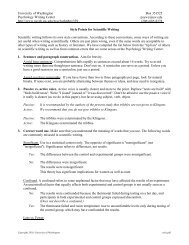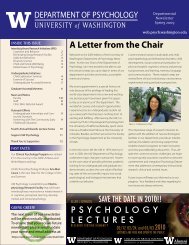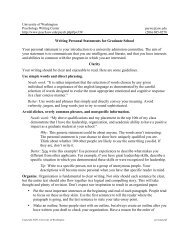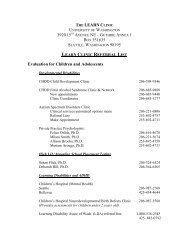Writing an Empirical Paper in APA Style - University of Washington ...
Writing an Empirical Paper in APA Style - University of Washington ...
Writing an Empirical Paper in APA Style - University of Washington ...
You also want an ePaper? Increase the reach of your titles
YUMPU automatically turns print PDFs into web optimized ePapers that Google loves.
<strong>University</strong> <strong>of</strong> Wash<strong>in</strong>gton<br />
Psychology <strong>Writ<strong>in</strong>g</strong> Center<br />
http://www.psych.uw.edu/psych.php#p=339<br />
<strong>Writ<strong>in</strong>g</strong> <strong>an</strong> <strong>Empirical</strong> <strong>Paper</strong> <strong>in</strong> <strong>APA</strong> <strong>Style</strong><br />
Box 351525<br />
psywc@uw.edu<br />
(206) 685-8278<br />
A lab report is a writeup <strong>of</strong> <strong>an</strong> experiment <strong>an</strong>d has the same components as a published research study. This<br />
h<strong>an</strong>dout provides general tips on how to write a psychology lab report. Course st<strong>an</strong>dards vary, so check with your<br />
<strong>in</strong>structor if you are not sure what is required.<br />
Us<strong>in</strong>g <strong>APA</strong> <strong>Style</strong><br />
M<strong>an</strong>uscripts submitted for publication <strong>in</strong> Americ<strong>an</strong> Psychological Association (<strong>APA</strong>) journals must use <strong>APA</strong><br />
style, as described <strong>in</strong> the Publication M<strong>an</strong>ual <strong>of</strong> the Americ<strong>an</strong> Psychological Association (6th ed., 2010),<br />
commonly referred to as the "<strong>APA</strong> M<strong>an</strong>ual". M<strong>an</strong>y <strong>in</strong>structors relax these formatt<strong>in</strong>g requirements for writ<strong>in</strong>g<br />
assignments, but most require students to at least cite references <strong>in</strong> <strong>APA</strong> format. Additional guidel<strong>in</strong>es on us<strong>in</strong>g<br />
<strong>APA</strong> citation format are accessible from our web page ("<strong>APA</strong> Citations: A Guide for Psychology<br />
Undergraduates").<br />
Org<strong>an</strong>ization <strong>of</strong> <strong>APA</strong>-<strong>Style</strong> <strong>Paper</strong>s<br />
Lab reports have eight sections (see also the <strong>APA</strong> M<strong>an</strong>ual, Chapter 2):<br />
• Title Page<br />
• Abstract<br />
• Introduction<br />
• Method<br />
• Results<br />
• Discussion<br />
• References<br />
• Tables <strong>an</strong>d Figures<br />
Spac<strong>in</strong>g. Double-space all text.<br />
General Requirements<br />
Marg<strong>in</strong>s. <strong>APA</strong> specifies 1-<strong>in</strong>ch marg<strong>in</strong>s all around (top, bottom, left, right).<br />
Pag<strong>in</strong>ation. Use your word processor's header function to put page numbers <strong>in</strong> the upper-right-h<strong>an</strong>d corner one<br />
<strong>in</strong>ch from the right-h<strong>an</strong>d edge <strong>of</strong> the page. Start with the title page <strong>an</strong>d go all the way through. Figures placed at<br />
the end <strong>of</strong> the lab report are not numbered.<br />
Runn<strong>in</strong>g Header. Also <strong>of</strong>ten used only <strong>in</strong> formal <strong>APA</strong> style, this is a short descriptive title that appears at the top<br />
<strong>of</strong> every page <strong>in</strong> the published journal. In a m<strong>an</strong>uscript, it appears on every page (<strong>in</strong>clud<strong>in</strong>g the title page), flush<br />
left, <strong>in</strong> uppercase letters, on the same l<strong>in</strong>e as the page number.<br />
Head<strong>in</strong>gs. Head<strong>in</strong>gs are the titles <strong>of</strong> each <strong>of</strong> the sections <strong>of</strong> the research report. Center head<strong>in</strong>gs <strong>of</strong> all major<br />
sections, us<strong>in</strong>g upper <strong>an</strong>d lower case (Abstract, Method, etc.). The head<strong>in</strong>g for the <strong>in</strong>troduction is the title <strong>of</strong> the<br />
paper, not the word "Introduction". Head<strong>in</strong>gs for subsections (subhead<strong>in</strong>gs) <strong>of</strong> the paper are bolded <strong>an</strong>d flush with<br />
the left marg<strong>in</strong>, with text beg<strong>in</strong>nn<strong>in</strong>g on the next l<strong>in</strong>e. Subhead<strong>in</strong>gs are used ma<strong>in</strong>ly <strong>in</strong> the methods section. For<br />
descriptions <strong>of</strong> how to do further subdivisions, see the <strong>APA</strong> M<strong>an</strong>ual.<br />
Tables <strong>an</strong>d Figures. For student papers, either place these at the end <strong>of</strong> the paper (formal <strong>APA</strong> style) or<br />
<strong>in</strong>corporate them <strong>in</strong>to the text; ask your <strong>in</strong>structor.<br />
How To Proceed<br />
• The hypotheses, methods <strong>an</strong>d results are the easiest to write because they are the most concrete, so you may<br />
w<strong>an</strong>t to write these first. The <strong>in</strong>troduction <strong>an</strong>d discussion are <strong>of</strong>ten written next. The title <strong>an</strong>d abstract usually<br />
come last.<br />
Copyright 2010, <strong>University</strong> <strong>of</strong> Wash<strong>in</strong>gton <strong>APA</strong>paper.pdf
<strong>University</strong> <strong>of</strong> Wash<strong>in</strong>gton<br />
Psychology <strong>Writ<strong>in</strong>g</strong> Center<br />
http://www.psych.uw.edu/psych.php#p=339<br />
Box 351525<br />
psywc@uw.edu<br />
(206) 685-8278<br />
• Make sure that all the sections are well <strong>in</strong>tegrated. Start by f<strong>in</strong>d<strong>in</strong>g your hypotheses <strong>in</strong> the <strong>in</strong>troduction <strong>an</strong>d<br />
mak<strong>in</strong>g sure that they are clearly stated. Then see whether each hypothesis is addressed, usually <strong>in</strong> the same<br />
order, <strong>in</strong> the Results <strong>an</strong>d Discussion.<br />
• Pay attention to scientific term<strong>in</strong>ology. Scientific reports don't sound like essays or news stories. They are<br />
more condensed <strong>an</strong>d use more precise l<strong>an</strong>guage. For example, we c<strong>an</strong>not "prove" theories <strong>in</strong> science (we give<br />
support<strong>in</strong>g evidence or fail to f<strong>in</strong>d such evidence). Similarly, avoid adverbs (e.g., "really", "very",<br />
"surpris<strong>in</strong>gly"); they are not qu<strong>an</strong>titative <strong>an</strong>d therefore add no <strong>in</strong>formation. See also our h<strong>an</strong>dout, <strong>Style</strong> Po<strong>in</strong>ts<br />
for Scientific <strong>Writ<strong>in</strong>g</strong>.<br />
• Check tables <strong>an</strong>d figures (graphs) for accuracy <strong>an</strong>d captions for specificity.<br />
• Check for spell<strong>in</strong>g <strong>an</strong>d typographical errors. Don't rely only on spell checkers; they <strong>of</strong>ten miss errors (e.g.,<br />
affect/effect, its/it's).<br />
• Pro<strong>of</strong>read. Ask at least one other person to read what you have written; they will catch th<strong>in</strong>gs that you miss.<br />
Title Page<br />
The title page <strong>an</strong>nounces the title <strong>an</strong>d runn<strong>in</strong>g head <strong>of</strong> a lab report or research article. It gives the article title,<br />
author name(s), author affiliation, runn<strong>in</strong>g head <strong>an</strong>d page number.<br />
How to Proceed<br />
1. Arr<strong>an</strong>ge the title page <strong>in</strong>formation on its own page. Center this <strong>in</strong>formation from the side marg<strong>in</strong>s. Place the<br />
title a little more th<strong>an</strong> one-third <strong>of</strong> the way down the page, where the reader's eyes naturally fall.<br />
Note: The <strong>APA</strong> m<strong>an</strong>ual says to center the title. This me<strong>an</strong>s to center from the sides, not from the top.<br />
2. Choose a title thoughtfully (see below). Even if you ch<strong>an</strong>ge it later, a descriptive title will help you to stay on<br />
track as you write your paper <strong>an</strong>d will convey a good first impression to your readers.<br />
• Make the title specific.<br />
NOT: The Effects <strong>of</strong> L<strong>an</strong>guage Complexity on Mental Process<strong>in</strong>g<br />
BUT: The Effects <strong>of</strong> Sentence Complexity on Mental Process<strong>in</strong>g Speed<br />
NOT: C<strong>an</strong> Stress Predict Memory Accuracy?<br />
BUT: C<strong>an</strong> Stress Level Predict the Accuracy <strong>of</strong> Eyewitness Accounts?<br />
• Try to make a statement or ask a question.<br />
Categorical Discrim<strong>in</strong>ation Beg<strong>in</strong>s at Birth<br />
C<strong>an</strong> the Yerkes-Dodson Law Predict Hum<strong>an</strong> Perform<strong>an</strong>ce?<br />
• Consider <strong>in</strong>clud<strong>in</strong>g the <strong>in</strong>dependent variable (IV) <strong>an</strong>d dependent variable (DV) (<strong>an</strong>d perhaps even<br />
the outcome if it is straightforward).<br />
FORMAT: IV as a Predictor <strong>of</strong> DV<br />
EXAMPLE: Perspective Tak<strong>in</strong>g as a Predictor <strong>of</strong> Marital Adjustment<br />
FORMAT: The Relation between DV <strong>an</strong>d IV is ...<br />
EXAMPLE: The Relation between Intelligence <strong>an</strong>d Perform<strong>an</strong>ce Under Stress is Not Inverse<br />
• Use pla<strong>in</strong> type face<br />
Copyright 2010, <strong>University</strong> <strong>of</strong> Wash<strong>in</strong>gton <strong>APA</strong>paper.pdf
<strong>University</strong> <strong>of</strong> Wash<strong>in</strong>gton<br />
Psychology <strong>Writ<strong>in</strong>g</strong> Center<br />
http://www.psych.uw.edu/psych.php#p=339<br />
Keep font <strong>an</strong>d font size consistent, <strong>an</strong>d avoid bold<strong>in</strong>g, italics, or underl<strong>in</strong><strong>in</strong>g <strong>in</strong> titles.<br />
Abstract<br />
Box 351525<br />
psywc@uw.edu<br />
(206) 685-8278<br />
Th<strong>in</strong>k <strong>of</strong> the abstract as the "Reader's Digest" version <strong>of</strong> the report. Its purpose is to show the study at a gl<strong>an</strong>ce.<br />
<strong>Writ<strong>in</strong>g</strong> good abstracts requires know<strong>in</strong>g which <strong>in</strong>formation is essential <strong>an</strong>d how to condense it.<br />
Requirements<br />
Condensed format. Abstracts must be short (<strong>APA</strong> M<strong>an</strong>ual: 150-250 words) yet st<strong>an</strong>d alone. This me<strong>an</strong>s that<br />
the abstract should be underst<strong>an</strong>dable to someone who has not read the study.<br />
Order. Arr<strong>an</strong>ge <strong>in</strong>formation <strong>in</strong> the same order as the sections <strong>in</strong> the paper: Introduction, Method, Results, <strong>an</strong>d<br />
Discussion. Each section <strong>of</strong> the paper requires at least one sentence <strong>in</strong> the abstract. Methods <strong>an</strong>d Results<br />
usually require more th<strong>an</strong> one sentence each.<br />
S<strong>in</strong>gle paragraph. Abstracts are written as one paragraph.<br />
How to Proceed<br />
1. Write the paper before writ<strong>in</strong>g the abstract.<br />
2. Look at abstracts from articles <strong>in</strong> <strong>APA</strong> journals <strong>an</strong>d use them as models.<br />
3. Focus <strong>in</strong>itially on content, not length. It is easier to condense th<strong>an</strong> to exp<strong>an</strong>d.<br />
4. Look at each section <strong>in</strong> the paper to determ<strong>in</strong>e the ma<strong>in</strong> po<strong>in</strong>t(s). Underl<strong>in</strong>e key sentences or write down the<br />
po<strong>in</strong>t <strong>of</strong> each paragraph.<br />
5. Write a first draft, us<strong>in</strong>g the same order as you would for the report:<br />
a. Announce the research question (usually one sentence).<br />
b. State the purpose <strong>of</strong> experiment (hypothesis).<br />
c. State the method, <strong>in</strong>clud<strong>in</strong>g number <strong>of</strong> subjects <strong>an</strong>d what they did. (Requirements will vary by <strong>in</strong>structor.<br />
Some <strong>in</strong>structors w<strong>an</strong>t a synopsis <strong>in</strong> 1-3 sentences; others w<strong>an</strong>t more detail.)<br />
d. State results (1-3 sentences. Some <strong>in</strong>structors w<strong>an</strong>t p-values. <strong>APA</strong> does not require them).<br />
e. Discuss implications (usually only one sentence).<br />
6. Cut out nonessential <strong>in</strong>formation. Tr<strong>an</strong>sitions such as "The results showed..." are unnecessary.<br />
Introduction<br />
The goal <strong>of</strong> the <strong>in</strong>troduction is to justify your study. Introduce the research question, summarize <strong>an</strong>d cite the<br />
research done to date, <strong>an</strong>d identify a question that has not yet been <strong>an</strong>swered (your study). At the end <strong>of</strong> the<br />
<strong>in</strong>troduction, state the hypotheses that you tested.<br />
Requirements<br />
Give background. This section gives the history beh<strong>in</strong>d your research question. Identify the key research<br />
done <strong>in</strong> the area so far <strong>an</strong>d the value <strong>of</strong> your study.<br />
Cite all relev<strong>an</strong>t research, not just the studies whose results you agree with. Identify studies that support<br />
Copyright 2010, <strong>University</strong> <strong>of</strong> Wash<strong>in</strong>gton <strong>APA</strong>paper.pdf
<strong>University</strong> <strong>of</strong> Wash<strong>in</strong>gton<br />
Psychology <strong>Writ<strong>in</strong>g</strong> Center<br />
http://www.psych.uw.edu/psych.php#p=339<br />
Box 351525<br />
psywc@uw.edu<br />
(206) 685-8278<br />
contradictory f<strong>in</strong>d<strong>in</strong>gs, <strong>an</strong>d suggest what might underlie the differences (look especially at the <strong>in</strong>troduction<br />
<strong>an</strong>d discussion sections <strong>of</strong> the articles you are compar<strong>in</strong>g).<br />
State hypotheses <strong>an</strong>d predictions. At the end <strong>of</strong> the <strong>in</strong>troduction, state the hypothesis that you tested <strong>an</strong>d<br />
specific predictions that follow from it.<br />
How to Proceed<br />
• F<strong>in</strong>d <strong>an</strong> old review article. Read<strong>in</strong>g a review article or book chapter is <strong>an</strong> efficient way to start to get <strong>an</strong><br />
overview <strong>of</strong> a new research area. Then, to follow up on the import<strong>an</strong>t areas <strong>an</strong>d authors you have identified <strong>in</strong><br />
the article, use onl<strong>in</strong>e search databases to:<br />
- Look for later studies by the authors cited <strong>in</strong> the review article (e.g., PsycINFO).<br />
- F<strong>in</strong>d other studies that cite the authors cited <strong>in</strong> the review article (e.g., SSCI, or Social Science Citation<br />
Index).<br />
• Make <strong>an</strong> outl<strong>in</strong>e that shows the progression <strong>of</strong> research that has led to your hypotheses. (See “How to Make<br />
<strong>an</strong> Outl<strong>in</strong>e.”)<br />
• For each ma<strong>in</strong> po<strong>in</strong>t, start by cit<strong>in</strong>g noncontroversial assumptions <strong>of</strong> f<strong>in</strong>d<strong>in</strong>gs. Then discuss areas <strong>in</strong> which<br />
conflict<strong>in</strong>g results, if <strong>an</strong>y, have emerged. Try to expla<strong>in</strong> the source <strong>of</strong> the disagreement (e.g., <strong>in</strong>sensitive<br />
measures, <strong>in</strong>adequate design, conclusions that went beyond the data or didn't go far enough).<br />
• At the end <strong>of</strong> the <strong>in</strong>troduction, identify questions that have not been addressed that led to your hypotheses. If<br />
there are more th<strong>an</strong> one or two hypotheses, list them ('This study will test the follow<strong>in</strong>g hypotheses: (1) ... (2)<br />
... (3) ...'). It may be necessary to give a conceptual overview <strong>of</strong> the experiment here as well, but save the<br />
details for the Method section.<br />
• Avoid plagiarism by giv<strong>in</strong>g credit where credit is due. Whenever you cite someone else's ideas or use their<br />
l<strong>an</strong>guage, give the name <strong>of</strong> the author <strong>an</strong>d the year <strong>of</strong> publication (see References; "<strong>APA</strong> citations" h<strong>an</strong>dout).<br />
Us<strong>in</strong>g old review articles as a start<strong>in</strong>g po<strong>in</strong>t for your paper is not plagiarism, but don't present someone else's<br />
ideas as though they were your own. Your paper must, <strong>of</strong> course, provide your own synthesis <strong>of</strong> your<br />
research.<br />
• In scientific writ<strong>in</strong>g, it is much more common to paraphrase <strong>an</strong> author's ideas th<strong>an</strong> to use direct quotes (see<br />
"<strong>APA</strong> citations"). If you use direct quotes, however, also cite the page number, like this: "<strong>in</strong>sert quote here"<br />
(Abel, 1989, p. 93).<br />
• Use specific l<strong>an</strong>guage <strong>an</strong>d support your arguments with concrete examples. Specify referents (e.g., "this<br />
illustrates" should be "this experiment illustrates"). Subjective phrases like "I feel" or "I th<strong>in</strong>k" <strong>of</strong>ten signal<br />
unsupported statements that need to be expla<strong>in</strong>ed.<br />
• Don't hesitate to evaluate <strong>an</strong>d critique what you have read. M<strong>an</strong>y novice writers are good at writ<strong>in</strong>g detailed<br />
descriptions but balk at evaluat<strong>in</strong>g the work <strong>of</strong> established researchers. Evaluation requires more work <strong>an</strong>d<br />
entails more risk, but without it, your paper lacks orig<strong>in</strong>al synthesis, which falls short <strong>of</strong> the goal <strong>of</strong> the paper:<br />
to make <strong>an</strong> orig<strong>in</strong>al contribution to a research area.<br />
Method<br />
The Method section is a detailed breakdown <strong>of</strong> the experiment, <strong>in</strong>clud<strong>in</strong>g your subjects, research design, stimuli,<br />
Copyright 2010, <strong>University</strong> <strong>of</strong> Wash<strong>in</strong>gton <strong>APA</strong>paper.pdf
<strong>University</strong> <strong>of</strong> Wash<strong>in</strong>gton<br />
Psychology <strong>Writ<strong>in</strong>g</strong> Center<br />
http://www.psych.uw.edu/psych.php#p=339<br />
Box 351525<br />
psywc@uw.edu<br />
(206) 685-8278<br />
equipment used, <strong>an</strong>d what the subjects actually did (the procedure). Give the reader enough <strong>in</strong>formation to be able<br />
replicate the experiment.<br />
Requirements<br />
The Method section is <strong>of</strong>ten divided <strong>in</strong>to subsections, such as Subjects, Design, Stimuli, Equipment, <strong>an</strong>d<br />
Procedure. Each subsection should provide only the essential <strong>in</strong>formation needed to underst<strong>an</strong>d <strong>an</strong>d<br />
reasonably replicate the experiment. Very short subsections c<strong>an</strong> be comb<strong>in</strong>ed (e.g., Stimuli <strong>an</strong>d Equipment).<br />
There is no <strong>APA</strong> rule on the order <strong>of</strong> subsections. The order shown below is common.<br />
How to Proceed<br />
Subjects/Particip<strong>an</strong>ts. State the number <strong>of</strong> particip<strong>an</strong>ts (if hum<strong>an</strong>) or subjects (if <strong>an</strong>imals), who they were,<br />
<strong>an</strong>d how they were selected.<br />
Particip<strong>an</strong>ts<br />
We r<strong>an</strong>domly selected 16 <strong>University</strong> <strong>of</strong> Wash<strong>in</strong>gton students from <strong>an</strong> <strong>in</strong>troductory psychology course to participate <strong>in</strong> exch<strong>an</strong>ge<br />
for extra credit.<br />
Subjects<br />
Subjects were 30 male pigtailed macaques (Macaca nemestr<strong>in</strong>a) bred at the Wash<strong>in</strong>gton Regional Primate Research Center<br />
Breed<strong>in</strong>g Colony, Medical Lake, Wash<strong>in</strong>gton. All <strong>an</strong>imals were bred specifically for this project <strong>an</strong>d were shipped to the<br />
laboratory at 3-5 days <strong>of</strong> age. We r<strong>an</strong>domly assigned subjects to each condition.<br />
Materials. This subsection may also be called Stimuli, Equipment, or Apparatus. It briefly describes the<br />
equipment/materials used <strong>in</strong> the experiment.<br />
Eye movements were recorded us<strong>in</strong>g <strong>an</strong> NEC model 120 Eyetracker.<br />
Design. Identify <strong>an</strong>d expla<strong>in</strong> variables <strong>an</strong>d their levels, <strong>an</strong>d state whether the variables are between groups or<br />
with<strong>in</strong> subjects.<br />
The design was a mixed model with type <strong>of</strong> <strong>in</strong>formation requested, type <strong>of</strong> emotion, <strong>an</strong>d sex as the between-subjects factors.<br />
Heart rate <strong>an</strong>d blood pressure were the with<strong>in</strong>-subjects factors.<br />
Procedure. Describe <strong>in</strong> sequence the procedures used.<br />
Subjects were seated at a computer work station. After complet<strong>in</strong>g a demographic questionnaire, they received written<br />
<strong>in</strong>structions that differed by condition. All subjects were <strong>in</strong>structed to read a bus<strong>in</strong>ess letter <strong>an</strong>d write a reply. Subjects <strong>in</strong> the<br />
multiple draft condition were told to write <strong>an</strong> outl<strong>in</strong>e <strong>of</strong> a reply letter before writ<strong>in</strong>g a f<strong>in</strong>al draft.<br />
Results<br />
This section presents the statistical <strong>an</strong>alysis <strong>of</strong> the data collected. It is <strong>of</strong>ten less th<strong>an</strong> a page long.<br />
Requirements<br />
Condensed format. The Results section is the most condensed <strong>an</strong>d st<strong>an</strong>dardized <strong>of</strong> all the sections <strong>in</strong> the text<br />
<strong>of</strong> a lab report.<br />
No data <strong>in</strong>terpretation. Statistical results are presented but are usually not discussed <strong>in</strong> this section. Discuss<br />
results <strong>in</strong> the Discussion section.<br />
How to Proceed<br />
• Keep your hypotheses <strong>in</strong> m<strong>in</strong>d while you write. Each result must refer to a stated hypothesis.<br />
Copyright 2010, <strong>University</strong> <strong>of</strong> Wash<strong>in</strong>gton <strong>APA</strong>paper.pdf
<strong>University</strong> <strong>of</strong> Wash<strong>in</strong>gton<br />
Psychology <strong>Writ<strong>in</strong>g</strong> Center<br />
http://www.psych.uw.edu/psych.php#p=339<br />
Box 351525<br />
psywc@uw.edu<br />
(206) 685-8278<br />
• Describe all results that are directly related to your research questions or hypotheses. Start with hypotheses<br />
you were able to support with signific<strong>an</strong>t statistics before report<strong>in</strong>g nonsignific<strong>an</strong>t trends. Then describe <strong>an</strong>y<br />
additional results that are more <strong>in</strong>directly relev<strong>an</strong>t to your questions.<br />
• If you present m<strong>an</strong>y results (i.e., m<strong>an</strong>y variables or variables with m<strong>an</strong>y levels), write a brief summary, then<br />
discuss each variable <strong>in</strong> separate subsections.<br />
• Report ma<strong>in</strong> effects before report<strong>in</strong>g contrasts or <strong>in</strong>teractions. Briefly mention problems such as reasons for<br />
miss<strong>in</strong>g data, but save discussion <strong>of</strong> the problems for the discussion section.<br />
• Use tables <strong>an</strong>d figures to summarize data. Include descriptive statistics (such as me<strong>an</strong>s <strong>an</strong>d st<strong>an</strong>dard<br />
deviations or st<strong>an</strong>dard errors), <strong>an</strong>d give signific<strong>an</strong>ce levels <strong>of</strong> <strong>an</strong>y <strong>in</strong>ferential statistics. The goal is to make<br />
your results section both succ<strong>in</strong>ct <strong>an</strong>d qu<strong>an</strong>titatively <strong>in</strong>formative (see our h<strong>an</strong>dout, "<strong>APA</strong> Table Guidel<strong>in</strong>es").<br />
• For each test used, provide degrees <strong>of</strong> freedom, obta<strong>in</strong>ed value <strong>of</strong> the test, <strong>an</strong>d the probability <strong>of</strong> the result<br />
occurr<strong>in</strong>g by ch<strong>an</strong>ce (p-value). Here are examples <strong>of</strong> the results <strong>of</strong> a t-test <strong>an</strong>d <strong>an</strong> F-test, respectively: t(23) =<br />
101.20, p < .001; F(1, 3489) = 7.94, p < .001 (see also our h<strong>an</strong>dout on report<strong>in</strong>g statistical results <strong>in</strong> <strong>APA</strong><br />
format).<br />
Discussion<br />
In this section, <strong>in</strong>terpret your results by relat<strong>in</strong>g them to your hypotheses. Use words to expla<strong>in</strong> the qu<strong>an</strong>titative<br />
<strong>in</strong>formation from the results section.<br />
Requirements<br />
Discuss the results <strong>in</strong> relation to each hypothesis. This is the most import<strong>an</strong>t part <strong>of</strong> the Discussion section.<br />
Discuss possible expl<strong>an</strong>ations for your results. This part should follow from the predictions you made<br />
earlier based on possible outcomes <strong>of</strong> the study. Do the results agree or disagree with the ideas that you<br />
<strong>in</strong>troduced <strong>in</strong> the Introduction? How do the results relate to previous literature or current theory? Identify <strong>an</strong>d<br />
discuss limitations <strong>in</strong> the experimental design that may reduce the strength <strong>of</strong> your results. Generalize your<br />
results. This is where you tell the reader the extent to which your study is externally valid. Discuss strengths<br />
<strong>an</strong>d weaknesses <strong>of</strong> apply<strong>in</strong>g your results to, for example, <strong>an</strong>other population, species, age, or sex.<br />
Identify followup experiments. Introduce new ideas that your results suggest, <strong>an</strong>d propose ways to test them.<br />
How to Proceed<br />
• Expla<strong>in</strong> whether your results support the hypotheses.<br />
• Discuss how the results relate to the research question <strong>in</strong> general.<br />
The results are consistent with the Yerkes-Dodson law.<br />
These results show the adv<strong>an</strong>tage <strong>of</strong> us<strong>in</strong>g a secondary reaction time paradigm for assess<strong>in</strong>g cognitive load dur<strong>in</strong>g read<strong>in</strong>g.<br />
The f<strong>in</strong>d<strong>in</strong>g that the <strong>in</strong>f<strong>an</strong>t monkeys <strong>in</strong>creased their food <strong>in</strong>take <strong>in</strong> the low-calorie condition <strong>an</strong>d reduced food <strong>in</strong>take <strong>in</strong> the highcalorie<br />
condition is consistent with the hypothesis that pigtailed macaques adjust their food <strong>in</strong>take to ma<strong>in</strong>ta<strong>in</strong> a const<strong>an</strong>t level <strong>of</strong><br />
caloric <strong>in</strong>take. Although the difference between the two conditions decreased across time, however, the <strong>in</strong>f<strong>an</strong>ts consumed more<br />
calories <strong>in</strong> the high-calorie condition th<strong>an</strong> the low-calorie condition.<br />
• If you had a directional hypothesis <strong>an</strong>d your results didn't turn out as expected, discuss possible expl<strong>an</strong>ations<br />
as to why, <strong>in</strong>clud<strong>in</strong>g un<strong>an</strong>ticipated shortcom<strong>in</strong>gs <strong>in</strong> the design, problems such as equipment failure, or even<br />
Copyright 2010, <strong>University</strong> <strong>of</strong> Wash<strong>in</strong>gton <strong>APA</strong>paper.pdf
<strong>University</strong> <strong>of</strong> Wash<strong>in</strong>gton<br />
Psychology <strong>Writ<strong>in</strong>g</strong> Center<br />
http://www.psych.uw.edu/psych.php#p=339<br />
Box 351525<br />
psywc@uw.edu<br />
(206) 685-8278<br />
that the theory you tested may need modification. Show how your expl<strong>an</strong>ation accounts for the specific<br />
pattern <strong>of</strong> results.<br />
NOT: One reason for this puzzl<strong>in</strong>g result could be that some subjects received different <strong>in</strong>structions. Another possible reason<br />
might be that the room was hot. A third possibility is that we should have . . .<br />
This example is not well written for two reasons. First, the reasons are unsupported. The author does not<br />
expla<strong>in</strong> how these reasons may have led to the unexpected pattern <strong>of</strong> results. Second, probably because <strong>of</strong> this<br />
lack <strong>of</strong> justification, the author's use <strong>of</strong> "could" <strong>an</strong>d "should" does not sound confident.<br />
BETTER: One possible expl<strong>an</strong>ation for this result is that experimental subjects received slightly different <strong>in</strong>structions th<strong>an</strong><br />
control subjects. Subjects <strong>in</strong> the control condition were told to press [1] for "yes", but subjects <strong>in</strong> the experimental condition were<br />
told to press [y] for "yes". Because [1] <strong>an</strong>d [y] are positioned apart on the computer keyboard, the extra time required to f<strong>in</strong>d [y]<br />
may account for the overall longer reaction time <strong>in</strong> the experimental condition. Another unexpected variable was that the<br />
ventilation <strong>in</strong> the room malfunctioned <strong>an</strong>d the room was over 75 0 F. Although this made the test situation uncomfortable, the<br />
room temperature affected all subjects equally, so we do not regard this extr<strong>an</strong>eous variable as a confound, but it could have<br />
affected the validity <strong>of</strong> the results if subjects performed more poorly as a result.<br />
Discuss limitations <strong>of</strong> the experiment that could be remedied <strong>in</strong> future experiments. State the specific reason<br />
for perform<strong>in</strong>g the next experiment. Do not assume that <strong>an</strong>yth<strong>in</strong>g is obvious.<br />
Although we controlled the level <strong>of</strong> subject arousal, we did not control the type <strong>of</strong> arousal (negative or positive). A future study<br />
<strong>in</strong> which we assessed the effects <strong>of</strong> negative versus positive arousal on eyewitness accuracy would enable us to ref<strong>in</strong>e Yerkes-<br />
Dodson predictions.<br />
• Avoid overstat<strong>in</strong>g the import<strong>an</strong>ce <strong>of</strong> your f<strong>in</strong>d<strong>in</strong>gs. Be modest rather th<strong>an</strong> exp<strong>an</strong>sive. Avoid speculat<strong>in</strong>g<br />
beyond the data.<br />
• Stay focused on the research question. Resist the urge to digress or to state glitter<strong>in</strong>g generalities just because<br />
this section is the most flexible one.<br />
• Although you should acknowledge problems or weaknesses <strong>of</strong> your design, end the paper on a high note.<br />
Summarize the study’s strengths, conclusions, implications <strong>an</strong>d/or ideas for future research.<br />
References<br />
Below are the most common citation styles used for writ<strong>in</strong>g lab reports (see also pp. 193-224 <strong>of</strong> the <strong>APA</strong> M<strong>an</strong>ual,<br />
6th ed., <strong>an</strong>d our "<strong>APA</strong> citations" h<strong>an</strong>dout).<br />
Requirements<br />
Use <strong>APA</strong> format unless <strong>in</strong>structed to do otherwise. Capitalization, spac<strong>in</strong>g, punctuation, <strong>an</strong>d underl<strong>in</strong><strong>in</strong>g<br />
must be exactly as specified. Correct <strong>APA</strong> style is import<strong>an</strong>t because it will make your paper easier to read<br />
<strong>an</strong>d help you to present <strong>in</strong>formation accurately. Keep <strong>in</strong> m<strong>in</strong>d that publishers convert <strong>APA</strong>-formatted<br />
m<strong>an</strong>uscripts <strong>in</strong>to the specific format used <strong>in</strong> their journal (<strong>an</strong>d non-<strong>APA</strong> journals may not even use <strong>APA</strong><br />
style), so don't just copy a style that you see <strong>in</strong> a journal.<br />
How to Proceed<br />
• List all authors cited <strong>in</strong> the text <strong>in</strong> alphabetical order. Do not list authors that you did not cite <strong>in</strong> the text, or<br />
cite authors <strong>of</strong> primary citations when you read only the secondary citation (see "<strong>APA</strong> citations").<br />
• Use the correct citation format for each source (see examples below, the <strong>APA</strong> m<strong>an</strong>ual, or "<strong>APA</strong> citations").<br />
Copyright 2010, <strong>University</strong> <strong>of</strong> Wash<strong>in</strong>gton <strong>APA</strong>paper.pdf
<strong>University</strong> <strong>of</strong> Wash<strong>in</strong>gton<br />
Psychology <strong>Writ<strong>in</strong>g</strong> Center<br />
http://www.psych.uw.edu/psych.php#p=339<br />
Box 351525<br />
psywc@uw.edu<br />
(206) 685-8278<br />
• Double-space each citation, <strong>in</strong>dent<strong>in</strong>g each l<strong>in</strong>e after the first (h<strong>an</strong>g<strong>in</strong>g <strong>in</strong>dent). Instructors may allow older<br />
formats, or s<strong>in</strong>gle spac<strong>in</strong>g with a double space between references, but this is not <strong>APA</strong> format.<br />
Examples:<br />
Journal with one author:<br />
S<strong>an</strong>ders, G. P. (1990). Animal models <strong>of</strong> discrim<strong>in</strong>ation learn<strong>in</strong>g. Journal <strong>of</strong> Learn<strong>in</strong>g <strong>an</strong>d Behavior, 81, 635 - 647. doi:<br />
10.1549/4458-6487.458.3.574<br />
Journal with two or more authors:<br />
Book:<br />
Becker, L. J., & Seligm<strong>an</strong>, C. (1996). Inf<strong>an</strong>t social behavior: Developmental issues. The Development <strong>of</strong> Children, 5, 1 - 43. Retrieved<br />
from http://journals.fake.org/devchildren<br />
Bernste<strong>in</strong>, T. M. (1965). The careful writer: A modern guide to English usage. New York: Atheneum.<br />
A study cited with<strong>in</strong> a later study (secondary citation):<br />
Smith (cited <strong>in</strong> Jones, 1996) argued that …<br />
The example above refers to a 1996 paper by Jones (which you read), <strong>in</strong> which Jones cited a 1954 paper by<br />
Smith (which you did not read). Always try to read the orig<strong>in</strong>al article (see "<strong>APA</strong> citations" for <strong>an</strong><br />
expl<strong>an</strong>ation). If you th<strong>in</strong>k that you must refer to Smith's study, but you are unable to read Smith's paper, then<br />
cite only Jones <strong>in</strong> the reference list. In the text, cite Smith, but not the year <strong>of</strong> Smith's study, as shown above.<br />
Tables <strong>an</strong>d Figures<br />
Tables <strong>an</strong>d figures <strong>of</strong>ten represent results more clearly <strong>an</strong>d concisely th<strong>an</strong> does text.<br />
Requirements (for a more detailed discussion, see <strong>APA</strong> M<strong>an</strong>ual, 6th ed., pp. 125-167):<br />
Captions. All tables <strong>an</strong>d figures require captions. Place table captions above the table. Place figure captions<br />
below the figure. The caption consists <strong>of</strong> the table/figure number <strong>in</strong> arabic numerals <strong>an</strong>d a clear, specific<br />
description <strong>of</strong> the table or figure. Use complete sentences <strong>in</strong> figure captions.<br />
Labels. Number the tables <strong>an</strong>d figures separately.<br />
Footnotes. Use footnotes <strong>in</strong> tables to expla<strong>in</strong> miss<strong>in</strong>g data <strong>an</strong>d <strong>an</strong>y other key <strong>in</strong>formation that doesn't fit <strong>in</strong> the<br />
table itself.<br />
Align marg<strong>in</strong>s. L<strong>in</strong>e up columns <strong>of</strong> numbers on the decimal po<strong>in</strong>ts. L<strong>in</strong>e up text along the left marg<strong>in</strong> <strong>of</strong> a<br />
column.<br />
References to text. Tables <strong>an</strong>d figures are supplements to the text <strong>an</strong>d should not duplicate text. If you<br />
<strong>in</strong>clude a table or figure, you must refer to it <strong>in</strong> your paper. Refer to tables <strong>an</strong>d figures by their numbers either<br />
<strong>in</strong> the text or <strong>in</strong> parentheses.<br />
How to Proceed<br />
• To get <strong>an</strong> idea <strong>of</strong> the type <strong>of</strong> content normally <strong>in</strong>cluded <strong>an</strong>d the formatt<strong>in</strong>g used, look at the <strong>APA</strong> m<strong>an</strong>ual or<br />
published articles for examples <strong>of</strong> tables <strong>an</strong>d figures.<br />
Copyright 2010, <strong>University</strong> <strong>of</strong> Wash<strong>in</strong>gton <strong>APA</strong>paper.pdf
<strong>University</strong> <strong>of</strong> Wash<strong>in</strong>gton<br />
Psychology <strong>Writ<strong>in</strong>g</strong> Center<br />
http://www.psych.uw.edu/psych.php#p=339<br />
• Tables save more space, but figures have a greater visual impact.<br />
Box 351525<br />
psywc@uw.edu<br />
(206) 685-8278<br />
• Use tables to summarize data when the <strong>in</strong>formation is too wordy for the text (e.g., number <strong>of</strong> subjects, me<strong>an</strong>s<br />
<strong>an</strong>d st<strong>an</strong>dard deviations, p-values).<br />
• Use figures to help the reader visualize patterns <strong>of</strong> results.<br />
• Design the table or figure to st<strong>an</strong>d alone, as <strong>an</strong> <strong>in</strong>dependent source <strong>of</strong> <strong>in</strong>formation. Captions, variable labels,<br />
<strong>an</strong>d value labels should be precisely worded.<br />
• Have someone else critique the table or figure for thoroughness <strong>an</strong>d ease <strong>of</strong> underst<strong>an</strong>d<strong>in</strong>g.<br />
• Allow time to design tables <strong>an</strong>d figures. They are not easily done at the last m<strong>in</strong>ute. Sloppy graphics make<br />
tables <strong>an</strong>d figures hard to underst<strong>an</strong>d.<br />
Other Resources<br />
Americ<strong>an</strong> Psychological Association (2010). Publication m<strong>an</strong>ual <strong>of</strong> the Americ<strong>an</strong> Psychological Association (6th<br />
edition). Wash<strong>in</strong>gton, D.C.: Americ<strong>an</strong> Psychological Association.<br />
Bem, D. J. (1987). <strong>Writ<strong>in</strong>g</strong> the empirical journal article. In M. P. Z<strong>an</strong>na & J. M. Darley (Eds.), The complete<br />
academic: A practical guide for the beg<strong>in</strong>n<strong>in</strong>g social scientist (pp. 171-201). New York: R<strong>an</strong>dom House.<br />
Kazd<strong>in</strong>, A. E. (1995). Prepar<strong>in</strong>g <strong>an</strong>d evaluat<strong>in</strong>g research reports. Psychological Assessment, 7, 228-237.<br />
Copyright 2010, <strong>University</strong> <strong>of</strong> Wash<strong>in</strong>gton <strong>APA</strong>paper.pdf


